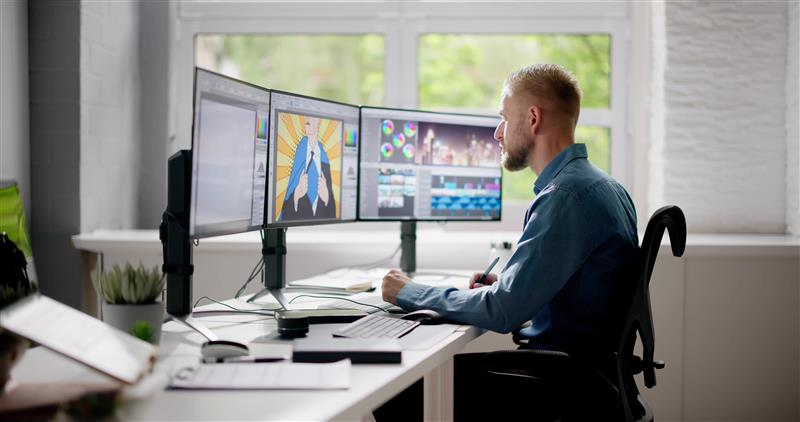Graphic designers have the unique ability to take basic information and transform it into visual concepts. Combining technical skill with creative ability, these designers work to design logos, create informational graphics, and develop visual branding strategies.
Those who are interested in the field of graphic design may opt to enroll in a graphic design program that provides them with skills-based training. Choosing the right graphic design courses will allow you to position yourself for success in this realm.
Core Principles of Graphic Design
Whether crafting a website design for an individual client or working to create a new logo for a large corporation, graphic designers rely on the core principles of graphic design to create effective and attractive visual graphics.
According to Adobe, key graphic design principles include:
- Prioritize alignment within all of your designs.
- Use hierarchy to emphasize the most important information within a design.
- Leverage the power of contrast to add emphasis within your design.
- Rely on repetition in order to create a consistent and cohesive design.
- Use proximity to create an organized design that is easy to digest.
- Give your designs form through balance.
- Use the basics of color theory to help people connect with your designs on an emotional level.
- Remember that negative space is necessary.
Understanding Color Theory
Color theory plays a pivotal part in graphic design, and aspiring graphic designers should know how to effectively use color theory to create compelling and effective graphic elements. Basic color theory can be broken down into three distinct categories:
- The color wheel – This element of traditional color theory provides an easy way to categorize colors. The basic, three-part color wheel includes primary colors, but there are also color wheels that include both primary and secondary colors.
- Color harmony – Within color theory, harmony has an integral role. It ensures that colors are paired in a pleasing way. Color harmony can be achieved by using analogous colors (or colors that are similar) as well as complementary colors, which are opposite each other on the color wheel.
- Color context – Defined as the way that color behaves and interacts with colors that are in close proximity, color context is vital to graphic design.
The Significance of Typography in Design
Typography is defined as the art of arranging written elements in a way that is visually pleasing, and it is often referred to as the voice of graphic design. For example, graphic designers choose specific fonts for their pieces in order to ensure that people can easily read the words included in the design. In addition, the fonts you choose to use can convey the message and tone of the piece — underscoring the importance of selecting the perfect font for the project.
Digital Design Tools and Software
Modern graphic designers rely almost exclusively on digital design tools and software to create their designs. As a result, it’s critical to choose a graphic design program that provides you with an opportunity to work with the leading design tools and develop the technical skills required for this field.
Essential Software for Graphic Designers
According to TechRadar, some of the best graphic design tools and software programs are:
- Adobe Photoshop – Adobe is the most popular graphic design software in the industry. Frequently described as the best in its class, Adobe Photoshop includes extensive features that give graphic designers incredible flexibility when creating and editing their work.
- Affinity Designer 2 – This vector-based software program works on both Windows and Mac devices, making it an excellent alternative to Adobe Photoshop.
- Canva – Perfect for those who are just beginning to develop and build their graphic design skills, Canva provides designers with both free and subscription-based options, depending on their needs. Canva is widely used by graphic designers who specialize in visual branding.
Advanced Tools for Professional Projects
Depending on the scope of your work or the area in which you specialize within the field of graphic design, you may need to become proficient in the most advanced industry tools. Some of the most advanced tools for graphic designers include Adobe Illustrator, Desygner, Pixelmator, Webflow, and more.
Developing a Design Portfolio
Throughout your graphic design program, you will want to create a design portfolio that showcases your best work. Your portfolio allows you to prove your competency in leading design skills while showcasing your creative abilities and unique approach to graphic design.
Best Practices for Portfolio Presentation
You can improve your overall portfolio presentation by:
- Including a wide range of graphic design samples.
- Categorizing your portfolio in order to present it in an organized manner.
- Incorporating text that sheds more insight into the design process and offers context about the sample.
How to Showcase Your Work Online
Most graphic designers have a physical portfolio as well as a digital portfolio. By creating an online portfolio website, you can easily share your work samples with prospective employers while simultaneously showcasing your digital graphic design skills throughout the site itself.
Frequently Asked Questions:
What is the best way to start learning graphic design?
The ideal way to explore the field of graphic design is to enroll in courses or a program that offers a skills-based graphic design curriculum. It is essential to select a graphic design program with hands-on training opportunities that allow you to become comfortable and confident when working with the best graphic design tools and software programs.
Can I learn graphic design without going to design school?
Although you can read about design theory and endeavor to teach yourself how to use various software, the most streamlined path to learning graphic design is enrolling in a program (online or in person) that prioritizes hands-on learning. Featuring courses taught by industry professionals and offering students an opportunity to work directly with the leading digital tools in graphic design, graphic design programs allow you to develop a strong foundation in design theory while also honing the practical, technical, and creative skills necessary in this field.
How important is software knowledge in graphic design?
Most graphic designers work exclusively with digital tools and software programs to create their designs. Thus, it is important to choose a graphic design program with a curriculum that incorporates essential software.
Explore the Graphic Design Program at Florida Technical College
If you are looking to develop the most in-demand graphic design skills, then it’s crucial to choose a graphic design program that delivers a skills-based curriculum including hands-on training opportunities. At Florida Technical College, we offer a Graphic Design Diploma Program that helps provide a pathway into this creative field. The curriculum for this 12-month program covers a wide range of visual communication skills — including sketching, typography, illustration, multimedia design, and more. After completing this graphic design program, you will have built upon the practical, creative, and technical skill set needed to plan, develop, and design graphic elements.
Request more information about our graphic design curriculum today.
This article presents a general overview of the field of graphic design, including job opportunities within that field; it does not describe the educational objectives or expected employment outcomes of a particular Florida Technical College program. Florida Technical College does not guarantee that students will obtain employment or any particular job. Some positions may require licensure or other certifications. We encourage you to research the requirements for the particular career you desire.
Sources
https://ftccollege.edu/program/diploma/graphic-design/
https://www.bls.gov/ooh/arts-and-design/graphic-designers.htm
https://www.colormatters.com/color-and-design/basic-color-theory
https://www.indeed.com/career-advice/career-development/typography
https://www.techradar.com/best/best-graphic-design-software
https://www.indeed.com/career-advice/career-development/graphic-design-tools



